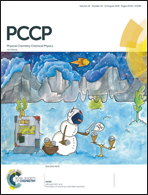F(2P) + C2H6 → HF + C2H5 kinetics study based on a new analytical potential energy surface
Abstract
An exhaustive kinetics study was performed for the title reaction using two theoretical approaches: variational transition-state theory and quasi-classical trajectory calculations, based on an original new analytical full-dimensional potential energy surface, named PES-2018, which has been fitted to high-level ab initio calculations. The theoretical results were compared with the available experimental data in the temperature range 189–350 K, a difficult comparison because of experimental controversies about the final rate constants (factor of about two) and on the activation energy (positive and negative values have been reported). There is agreement between the two theoretical approaches, with differences of less than 20%, and with the most recent experiments, with differences of less than 30%. Both theories gave small and positive activation energies, reasonably reproducing the most recent experiments, although they showed less dependence on temperature. To understand the theory/experiment differences, several sources of error were analysed, without discarding experimental uncertainties, such as limitations of the theoretical tools (PES and kinetics approaches), and the manner in which spin–orbit effects were included in the present non-relativistic study. Finally, H/D and 12C/13C kinetics isotope effects were reported for the first time for the title reaction, though unfortunately no experimental data are available for comparison.

- This article is part of the themed collection: 2018 PCCP HOT Articles


 Please wait while we load your content...
Please wait while we load your content...